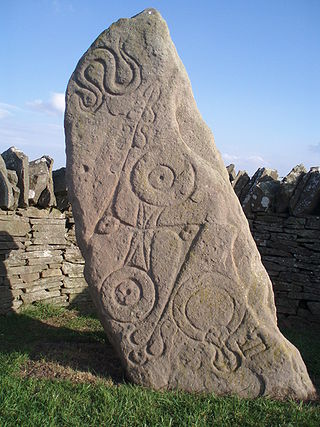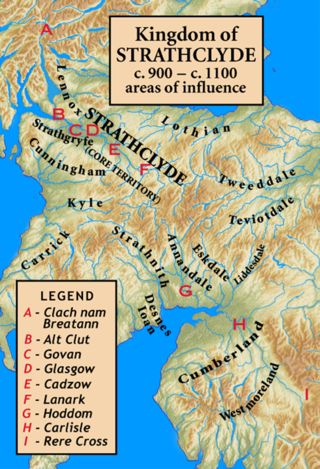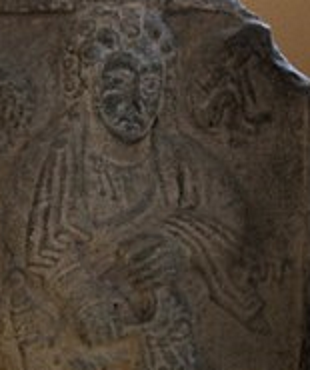Related Research Articles
Áed mac Cináeda was a son of Cináed mac Ailpín. He became king of the Picts in 877, when he succeeded his brother Constantín mac Cináeda. He was nicknamed Áed of the White Flowers, the wing-footed or the white-foot.

The Picts were a group of peoples who lived in Britain north of the Forth–Clyde isthmus in the Pre-Viking, Early Middle Ages. Where they lived and details of their culture can be inferred from early medieval texts and Pictish stones. The term Picti appears in written records as an exonym from the late third century AD, but was adopted as an endonym in the late seventh century during the Verturian hegemony. This lasted around 160 years until the succession of the Alpínid dynasty, when the Pictish kingdom merged with that of Dál Riata to form the Kingdom of Alba. The concept of "Pictish kingship" continued for a few decades until it was abandoned entirely as a contemporary signifier during the reign of Caustantín mac Áeda.

Strathclyde, was a Brittonic successor state of the Roman Empire and one of the early medieval kingdoms of the Britons, located in the region the Welsh tribes referred to as Yr Hen Ogledd, which comprised the Brythonic-speaking parts of what is now southern Scotland and northern England. The kingdom developed during Britain's post-Roman period. It is also known as Alt Clut, a Brittonic term for Dumbarton Castle, the medieval capital of the region. It may have had its origins with the Damnonii people of Ptolemy's Geography.

The Battle of Dun Nechtain or Battle of Nechtansmere was fought between the Picts, led by King Bridei Mac Bili, and the Northumbrians, led by King Ecgfrith, on 20 May 685.
Pictish is the extinct Brittonic language spoken by the Picts, the people of eastern and northern Scotland from Late Antiquity to the Early Middle Ages. Virtually no direct attestations of Pictish remain, short of a limited number of geographical and personal names found on monuments and the contemporary records in the area controlled by the kingdoms of the Picts, dating to the early medieval period. Such evidence, however, points strongly to the language being an Insular Celtic language related to the Brittonic language spoken prior to Anglo-Saxon settlement in what is now southern Scotland, England, and Wales.

Atholl or Athole is a large historical division in the Scottish Highlands, bordering Marr, Badenoch, Lochaber, Breadalbane, Strathearn, Perth, and Gowrie. Historically it was a Pictish kingdom, becoming one of the original provinces of the Kingdom of Alba before being incorporated into the sheriffdom and later county of Perthshire. Today it forms the northern part of Perth and Kinross, Scotland.
Talorgan son of Eanfrith was a King of the Picts from 653 to 657. As with his successors Gartnait son of Donuel and Drest son of Donuel, he reigned as a puppet king under the Northumbrian king Oswiu.

Óengus son of Fergus, was king of the Picts, of possible Gaelic origin, from 732 until his death in 761. His reign can be reconstructed in some detail from a variety of sources. The unprecedented territorial gains he made from coast to coast, and the legacy he left, mean Óengus can be considered the first king of what would become Scotland.
The Battle of Two Rivers was fought between the Picts and Northumbrians in the year 671. The exact battle site is unknown. It marked the end of the Pictish rebellion early in the reign of Ecgfrith, with a decisive victory for the Northumbrians. Attestation of the battle is limited to the account in Stephen of Ripon's Vita Sancti Wilfrithi.

Fortriu was a Pictish kingdom recorded between the 4th and 10th centuries. It was traditionally believed to be located in and around Strathearn in central Scotland, but is more likely to have been based in the north, in the Moray and Easter Ross area. Fortriu is a term used by historians as it is not known what name its people used to refer to their polity. Historians also sometimes use the name synonymously with Pictland in general.

Bridei son of Beli ; died 692) was king of Fortriu and of the Picts from 671 until 692. His reign marks the start of the period known to historians as the Verturian hegemony, a turning point in the history of Scotland, when the uniting of Pictish provinces under the over-kingship of the kings of Fortriu saw the development of a strong Pictish state and identity encompassing most of the peoples north of the Forth.
Nechtan, son of Erip, was the king of the Picts from 456 to 480.
Gartnait son of Donuel was king of the Picts from 657 until 663.
Drest son of Donuel was king of the Picts from c. 663 until 672. Like his brother and predecessor Gartnait son of Donuel, and Gartnait's predecessor Talorgan son of Eanfrith, he reigned as a puppet king under the Northumbrian king Oswiu. Gartnait and Drest may have been sons of Domnall Brecc, who was king of Dál Riata from c.629 until he was killed in 642.
Talorg son of Uuid was a king of the Picts from 641 to 653.

Scotland was divided into a series of kingdoms in the early Middle Ages, i.e. between the end of Roman authority in southern and central Britain from around 400 CE and the rise of the kingdom of Alba in 900 CE. Of these, the four most important to emerge were the Picts, the Gaels of Dál Riata, the Britons of Alt Clut, and the Anglian kingdom of Bernicia. After the arrival of the Vikings in the late 8th century, Scandinavian rulers and colonies were established on the islands and along parts of the coasts. In the 9th century, the House of Alpin combined the lands of the Scots and Picts to form a single kingdom which constituted the basis of the Kingdom of Scotland.

Cé was a Pictish territory recorded during the Early Medieval period and located in the area of modern-day Aberdeenshire, Scotland.

The Christianisation of Scotland was the process by which Christianity spread in what is now Scotland, which took place principally between the fifth and tenth centuries.
The Battle of Strathyre took place in 654 near Balquhidder in the Scottish Highlands, between the forces of Talorgan son of Eanfrith of the Picts and Dúnchad mac Conaing of Dál Riata.
References
- Calise, J. M. P. (2002). "Personal Names Associated with the Picts: Biographical and Textual Notes". Pictish Sourcebook: Documents of Medieval Legend and Dark Age History. Westport, CT: Greenwood Publishing Group. pp. 171–261. ISBN 9780313322952.
- Clarkson, Tim (2016). The Picts: A History. Edinburgh: Birlinn. ISBN 9781780274034.
- Fraser, James E. (2009). From Caledonia to Pictland: Scotland to 795. New Edinburgh History of Scotland. Edinburgh: Edinburgh University Press. ISBN 9780748612321.
- Smyth, Alfred P. (1989). Warlords and Holy Men: Scotland, A.D.80-1000. New History of Scotland. Edinburgh: Edinburgh University Press. ISBN 9780748601004.